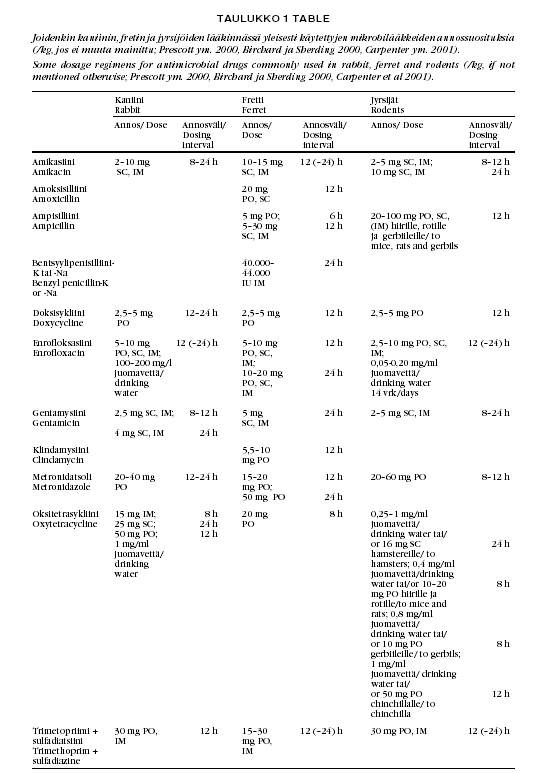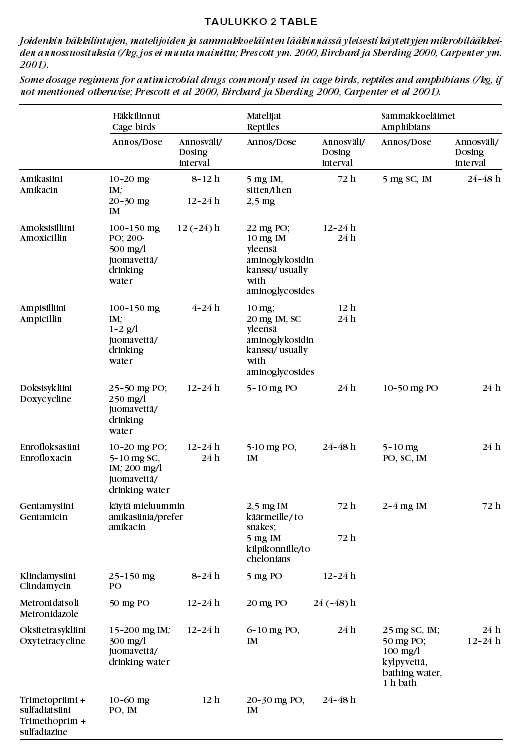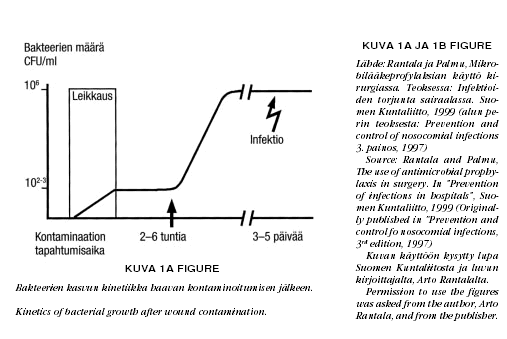
Antimicrobials are among one of most important discoveries of last century. However, their usability for treating infectious diseases is threatened by rapidly expanding antimicrobial resistance. Antimicrobials should be used only when a bacterial infection is strongly suspected or known to be present. This sets requirements to a veterinarian for infection diagnostics. When an antimicrobial agent is needed, the veterinarian should choose an agent, which has as narrow a spectrum as possible and which has pharmacokinetic features that ensure adequate drug concentration at the site of infection. The veterinarian can adjust a dosage if needed, but safety and toxicity aspects should be kept in mind. The prophylactic use of antimicrobials is indicated only where proven to be effective, such as in short term postoperative wound infection prophylaxis. In addition to the certain antimicrobials that are legally prohibited in animals in Finland, also mupirocin and azithromycin should not be used in animals, because these agents are valuable in treating problematic infectious diseases in humans. The prevention of the spread of resistance must be encouraged at all levels; both authorities and veterinarians can retard the development of antimicrobial resistance through their own practice.

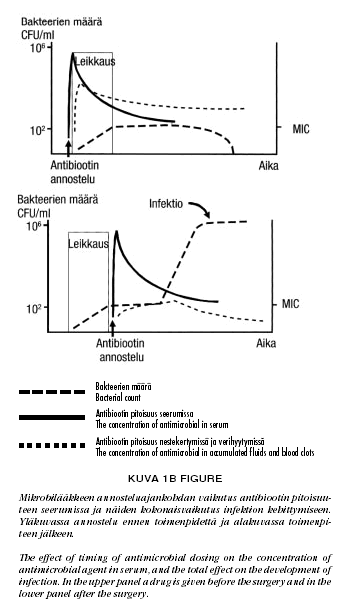
The review concerns the etiology, diagnostics and antimicrobial therapy of the most common canine bacterial respiratory infections. Most bacterial upper and lower respiratory tract infections are secondary to predisposing abnormality, such as viral infections, especially in young animals, immunosupression and structural and functional lesions. The choice of antibiotics should be based on accurate diagnosis, the knowledge of possible etiologic agents and the properties of bacteria as well as the age and concurrent diseases of the patient. Upper respiratory tract diseases, such as rhinitis, and lower respiratory tract diseases, including kennel cough complex (infectious tracheobronchitis), chronic bronchitis, bacterial pneumonia and pyothorax, are discussed in detail.
Acute diarrhea in dog is seldom of primary bacterial origin and it is usually self-limiting. Campylobacter spp., Salmonella spp., Shigella spp. and Yersinia enterocolitica may cause diarrhea in dogs, but they are frequently isolated in the feces of healthy animals, too. Bacterial infections are most often seen in young and kennelled animals and in immune deficient individuals. Therapy of acute diarrhea is based on fluid therapy and bowel rest, antibiotics are indicated only if patient has symptoms of bacteraemia (fever, apathy, degenerative left shift), severe hemorrhagic diarrhea or neutropenia. The aim of antibiotic therapy is to prevent and treat bacteraemia. Medication is started parenterally and, if needed, continued orally. Five-day treatment is usually sufficient. Antibiotics have always their effect on the normal intestinal flora. An unjudicious antibiotic choice may worsen and prolong the symptoms, and predispose the animal to pathogen colonization and even to sepsis. Zoonotic pathogens are often isolated from the feces of dogs. Use of antibiotics will favour the growth of resistant strains and prolongs the faecal shedding of pathogens. Chronic diarrhoeas should be controlled by diet and elimination of predisposing factors. However, antibiotics are often needed in the treatment.
Bacteria most frequently involved in urinary tract infection (UTI) include Escherichia coli, Proteus spp, staphylococci and streptococci, Klebsiella spp, Enterobacter spp and Pseudomonas spp. The diagnosis of UTI is based on clinical signs, and confirmed by examination and quantitative culture of the urine sample. Normally, specimens collected by cystosentesis are bacteriologically sterile, but samples colleted by means other than cystocentesis may contain bacteria, protein and white blood cells as contaminants from lower urinary tract and genitalia. Before the treatment is undertaken, the UTI should be classified as simple or complicated. A lower UTI (cystitis) of adult female dogs usually represents a simple UTI due to transient and reversible abnormality of the host defences. In complicated UTI a damage in urothelium, such as urolithiasiasis, neoplasia, micturation disorder, anatomic defect or underlying immunosuppressive disease or medication can be demonstrated or infection has extended to upper urinary tract causing pyelonephritis. The UTI of male dogs is also considered complicated, prostatitis accompanying most cases of the UTI. The choice of an antimicrobial to treat the UTI is based on ability of the drug to reach an effective concentration in the urinary tract. In general, concentrations of antibiotics in urine will exceed those in serum if antimicrobial is excreted in active form in urine. Trimethoprim-sulfonamide is the first choice for most UTIs. Alternatives include amoxicillin, cephalexin, amoxicillin-clavulanic acid and fluoroquinolones. The duration of therapy in simple UTI is 7 to 10 days and in complicated UTI 30 days. In recurrent UTIs prophylactic, low-dose therapy with e.g. trimethoprim-sulfonamide can be instituted. The dose is one half to one third of the ordinary dose and should be administered once daily (overnight). Effect of therapy should be controlled after medication for treatment failure.
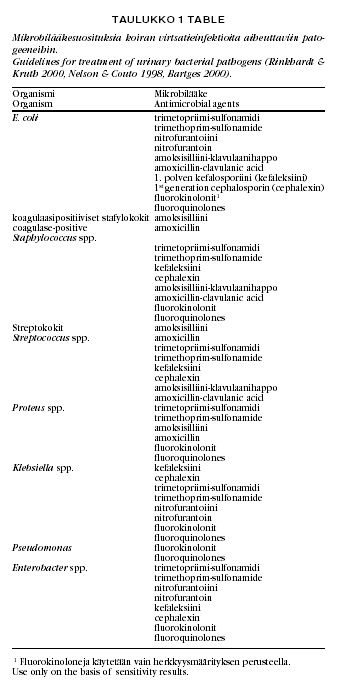
The paper reviews use of systemic antibiotics in the treatment of canine pyoderma and factors, which are essential for the successful outcome of the therapy. Staphylococcus intermedius is the main pathogen in canine
pyoderma. In some cases of deep pyoderma, gram-negative bacteria may also be involved. Macrolides, lincosamides and potentiated sulfonamides are usually effective for first occurence of pyoderma, otherwise their use should be based on sensitivity testing. Beta-lactamase resistant antibiotics, such as amoxycillinclavulanic acid and first generation cephalosporins, are usually effective in cases of recurrent and deep pyoderma. Use of fluoroquinolones should be reserved for difficult cases. Duration of the treatment has to be long enough to eliminate the bacterial infection completely, which often takes several weeks, even months. Therefore, potential side effects have to be considered when choosing the antibiotic in each individual case. Underlying diseases predisposing to canine pyoderma, such as allergic and endocrine diseases, keratinisation disorders and ectoparasites have to be identified and treated.
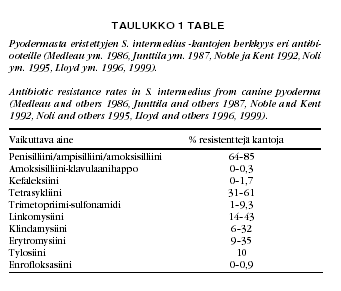
Central nervous system (CNS) infections in the dog and cat are rare. They are, however, life threatening and need aggressive antimicrobial therapy. Neurological symptoms are occasionally seen in tick-borne infections, such as ehrlichiosis and borreliosis. A short literature review about some bacterial CNS infections and their therapy is presented.
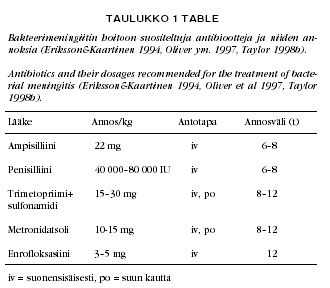
The paper presents recommendations to the judicious therapeutic use of antimicrobials in cats by careful patient, history and infection evaluation in order to prevent or minimize the development of antimicrobial related risks. Also practical antimicrobial therapies against the most common dermatological, ophtalmological, respiratory, thoragic, gastrointestinal, urinary tract ja genital infections will be presented.
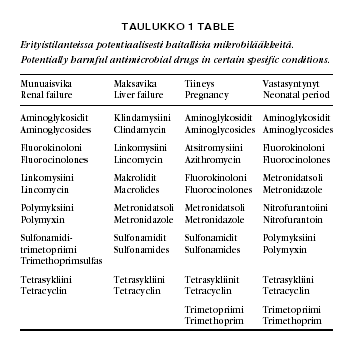
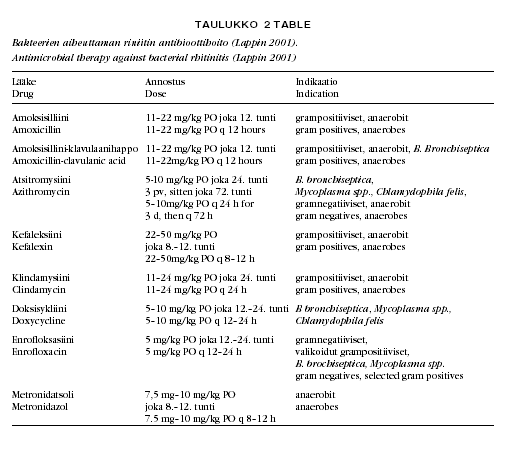
The number of exotic animals as veterinary patients has increased, which in turn has increased the need for more information on these patients. Antimicrobial therapies are very common clinical situations. Many factors must be taken into consideration when choosing the drug, route of administration and dosage. Usually the veterinarian gives the first injection and the owner continues the therapy by oral administration. Certain antimicrobial drugs should be avoided when treating rabbits or rodents due to enterotoxic or direct toxic effects of these drugs: amoxicillin, ampicillin, penicillin, clindamycin, lincomycin, tetracyclines (guinea pig), and sometimes cephalosporins, tylosin and erythromycin. Antimicrobial agents often used in rodents are enrofloxacin, sulfa-trimethoprim and aminoglycosides. Broad-spectrum antibiotics or combination therapy (e.g. some beta-lactam and aminoglycoside) are often used in the treatment of life-threatening infections in birds. Amoxicillin, ampicillin, enrofloxacin and tetracyclines are widely used in birds. Gram-negative multiresistant bacteria (e. g. Pseudomonas aeruginosa) are often causative agents in infections in reptiles, which is the reason for wide use of aminoglycosides and enrofloxacin in them. When using aminoglycosides their potential nephrotoxity must be taken into consideration and fluids must be given to the patients. Salmonellosis in reptiles should never be treated with antimicobial drugs.
